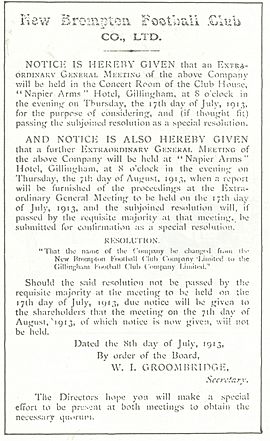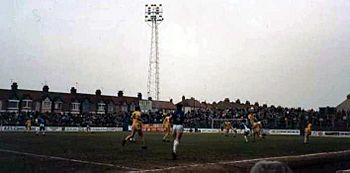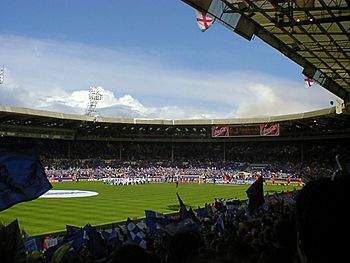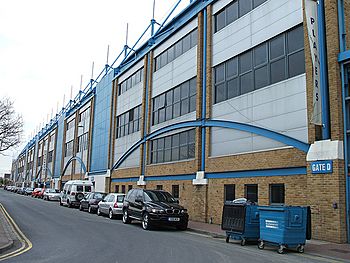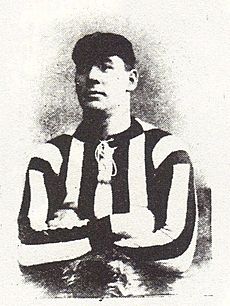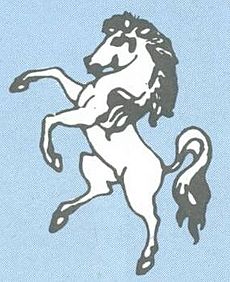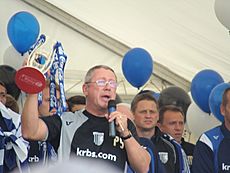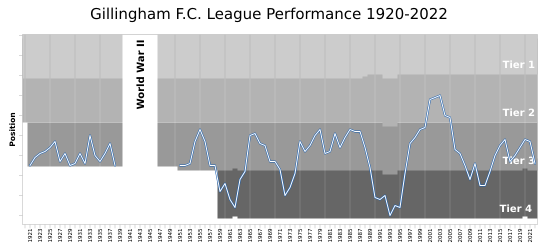Gillingham F.C. facts for kids
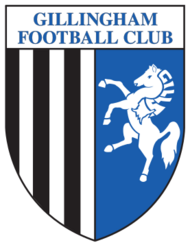 |
|||
| Full name | Gillingham Football Club | ||
|---|---|---|---|
| Nickname(s) | The Gills | ||
| Founded | 1893 (as New Brompton) |
||
| Ground | Priestfield Stadium | ||
| Capacity | 11,582 | ||
| Owner | Brad Galinson | ||
| Chairman | Brad Galinson | ||
| Manager | Gareth Ainsworth | ||
| League | League One | ||
| 2018–19 | League One, 13th of 24 | ||
|
|
|||
Gillingham Football Club is a professional football team from Gillingham, Kent, England. They play their home games at Priestfield Stadium. For the 2024–25 season, they competed in League Two, which is the fourth level of English football.
The club started in 1893 as New Brompton Football Club. They changed their name to Gillingham Football Club in 1912. The team played in the Southern Football League before joining the Football League in 1920. After 18 tough seasons, they were voted out of the league in 1938. They returned to the Southern League.
Gillingham rejoined the Football League in 1950 when more teams were added. In the late 1980s, they almost reached the second level of English football. However, their performance then dropped, and in 1993, they nearly fell out of the Football League entirely.
Between 2000 and 2005, Gillingham played in the second tier of English football. This was the only time in their history they reached this level. Their highest finish was eleventh place in the 2002–03 season. The club has won the championship of the fourth tier twice. They won in 1963–64 under manager Freddie Cox and again in 2012–13 under Martin Allen.
Gillingham first wore black and white striped shirts. They switched to blue shirts in the 1930s. The club's badge usually shows the white horse symbol of Kent county. Priestfield Stadium has always been their home ground. It used to hold up to 30,000 fans, but now its capacity is less than half that.
Contents
Club History
How it All Started
A local junior team, Chatham Excelsior F.C., was very successful. This inspired some business people to create a new football club. They wanted a team that could play in bigger competitions. New Brompton F.C. was formed on May 18, 1893. New Brompton was a town next to Gillingham.
The founders also bought the land that later became Priestfield Stadium. The new club played its first game on September 2, 1893. They lost 5–1 to Woolwich Arsenal's reserve team. About 2,000 people watched the match. New Brompton was one of the first teams in the Southern Football League when it started in 1894. They were placed in Division Two. They won the championship in their first season (1894–95). They then beat Swindon Town in a special match to get promoted.
In the years that followed, the club struggled in Division One. They finished last in the 1907–08 season. They avoided being relegated only because the league expanded. Even though their league performance was not great, they had a famous cup win against Sunderland. They also drew with Manchester City before losing in a replay.
In 1912, the club decided to change its name to Gillingham F.C. The team played under this name during the 1912–13 season. The change was officially approved by shareholders the next year. The team finished last in Division One in the 1919–20 season. For the third time, they avoided relegation. This happened because all Southern League Division One clubs joined the new Football League Division Three.
Joining the Football League
In the first season of the new Football League Division Three, 1920–21, Gillingham finished last again. In the following years, they did not improve much. The club kept finishing near the bottom of the lowest division. In 1938, the team finished last in the Third Division (South). They had to ask to be re-elected to the league for the fifth time. This request failed, and Gillingham went back to the Southern League. Ipswich Town took their place.
Gillingham quickly became one of the strongest teams in the Southern League. They won two local trophies, the Kent League and Kent Senior Cup, in the 1945–46 season. In the 1946–47 season, the team won both the Southern League Cup and the Southern League championship. During this time, they had a club record 12–1 victory over Gloucester City. The Gills also won the league title in 1948–49.
Back in the Football League
In 1950, the Football League Division Three (South) was set to grow from 22 to 24 teams. Because of their recent success, Gillingham was voted back into the Football League by a large margin. The team spent eight seasons in Division Three (South). Then, the league system changed for the 1958–59 season. Gillingham was placed in the new Fourth Division.
They stayed in this division until 1964. Manager Freddie Cox led them to promotion, winning the club's first championship. The team finished the season tied with Carlisle United on 60 points. Gillingham won because they had a slightly better goal average.
After being relegated back to the Fourth Division in 1970–71, the Gills were soon promoted back to the Third Division in the 1973–74 season. After this, the club seemed to settle in Division Three. They often tried to get promoted but always fell short. They came very close in 1986–87. They reached the play-offs but lost in the final to Swindon Town. During this time, the club helped develop future stars like Steve Bruce and Tony Cascarino. Cascarino was famously bought from a non-league team for just a set of tracksuits!
In 1987, the Gills made headlines. On two weekends in a row, they beat Southend United 8–1 and Chesterfield 10–0. The 10–0 win was a club record for a Football League match. However, just a few months later, manager Keith Peacock was surprisingly fired. Within 18 months, the club had dropped into Division Four. The time in the lower division was not very successful. In the 1992–93 Division Three season, the Gills barely avoided being relegated to the Football Conference.
Recent Ups and Downs
The club faced money problems and went into administration in January 1995. By the end of the 1994–95 season, they were at risk of being kicked out of the Football League. However, in June 1995, a businessman named Paul Scally bought the club. He brought in a new manager, Tony Pulis. Pulis led Gillingham to promotion in his first season, finishing second in the old Division Three (now Football League Two).
In 1999, the Gills reached the play-offs again but lost in the final to Manchester City. Gillingham was winning 2–0 with less than two minutes left. But City scored twice, including an equalizer in injury time, and then won 3–1 in a penalty shoot-out. Soon after this loss, Pulis was fired. Peter Taylor became the new manager. In the 1999–00 season, Gillingham qualified for the play-offs again. They faced Wigan Athletic in the final at Wembley Stadium. The game was 1–1 after 90 minutes. But goals in extra time from substitutes Steve Butler and Andy Thomson helped the Gills win 3–2. They were promoted to Division One for the first time ever!
Taylor then left to manage Leicester City. Andy Hessenthaler became the player-manager. He led the club to their best ever league finish of eleventh place in the 2002–03 season. But the next season, the club barely avoided relegation based on goal difference. Hessenthaler resigned as manager in November 2004. The new boss, Stan Ternent, could not stop the Gills from being relegated to League One.
At the end of the 2007–08 season, the club was relegated again, this time to League Two. But they quickly returned to the third level through the play-offs. They beat Shrewsbury Town in the final. In the 2009–10 season, however, the Gills dropped into the bottom four on the last day. They were relegated back to League Two, having not won a single away game all season. This led to manager Mark Stimson's contract ending. Andy Hessenthaler was appointed manager for the second time.
At the start of the 2012–13 season, Hessenthaler was replaced by Martin Allen. He led the club to promotion as League Two champions in his first season. However, shortly after winning League Two, Allen was surprisingly fired after a poor start to the next season. The club stayed in League One from 2013 until 2022. Their best finish was ninth place in the 2015–16 season. In the 2021–22 season, Gillingham was relegated back to League Two. In December 2022, Brad Galinson, a property businessman from Florida, bought most of the club's shares. Scally kept a smaller share. In January 2023, the club confirmed that Galinson would also become the Chairman.
Priestfield Stadium: The Home Ground
The Gills have always played at Priestfield Stadium. The club's founders bought the land by selling 1,500 shares, each costing £1. It's not clear if the stadium was named after Priestfield Road, or if the road was named after the stadium.
The ground was greatly improved before the 1930s. But then, not much changed until the late 1990s when Paul Scally became chairman. Three of the four stands were torn down and rebuilt between 1995 and 2000. The fourth stand, called the Town End, was also demolished. A new stand was planned to be named the Brian Moore Stand, after the famous sports commentator Brian Moore, who was a big Gills fan. However, the club's money situation has not allowed the new stand to be built. A temporary stand was put up in 2003 and is still there today.
From 2007 to 2010, the stadium was officially called KRBS Priestfield Stadium because of a sponsorship deal. In 2011, it was renamed MEMS Priestfield Stadium due to another agreement.
At its busiest in the 1940s, the stadium could hold "between 25,000 and 30,000" fans. But after modern changes, removing standing areas, and building new facilities, the current capacity is 11,582. In the 2018–19 season, the average attendance at home matches was 5,128. The stadium has also hosted games for the England women's national football team. The club's training ground is Beechings Cross in Gillingham.
Team Colours and Crest
Gillingham is known for its blue and white colours. However, the original New Brompton team wore black and white striped shirts with black shorts. In 1913, they changed to red shirts with blue sleeves, featuring the town's coat of arms.
The striped shirts returned after World War One. Then, in 1931, they were replaced by the familiar plain blue shirts and white shorts. In recent years, there have been different versions of the blue and white. In the late 1990s, the team wore blue and black striped shirts, similar to the original New Brompton stripes.
In 2003, it was announced that the main shirts for the next season would be mostly white. This caused a lot of anger among fans. So, the white strip was replaced with blue and black hoops, which was originally meant to be the third kit. In March 2010, the club announced a return to black and blue stripes for the 2010–11 season.
To celebrate 100 years since the club's name change, the 2012–13 kit was red with blue sleeves and collar. The club's crest was replaced by the town's crest. After winning the League Two title in 2012–13, fans voted to return to a blue and white kit for the 2013–14 season. Blue and white, or blue with black stripes, have been used since then.
The club's current crest (badge) is a shield split into two halves. One half has black and white stripes, and the other is solid blue. This shows the club's original and modern kit colours. On the blue half is the symbol of Kent county: a white horse standing on its hind legs. The horse's mane is shaped to look like the word "Gills." This side sometimes has a red or pink background to match away kits.
The club's motto, found below the crest, is Domus clamantium. This is Latin for "the home of the shouting men." This phrase is traditionally linked to the town of Gillingham. The club's mascot, Tommy Trewblu, is a horse, matching the crest. He first appeared at a match in October 1998.
The first sponsor's name on Gillingham shirts was Zanussi, an Italian home appliance company, in the mid-1980s. Other sponsors have included Chatham Maritime, Medway Toyota, Cannon Tool Hire, Invicta FM, Kool, Medway News, SeaFrance, MHS Homes Group, Kent Reliance Building Society, Automatic Retailing, MEMS Power Generation, Medway Council, and Bauvill.
Players
Current Squad
|
|
Player of the Season Award
Gillingham's Player of the Season award is chosen by the club's fans. It started in the 1968–69 season.
|
|
|
Club Officials
As of November 15, 2024
Management Team
| Position | Name |
|---|---|
| Chairman/Owner | Brad Galinson |
| Board of Directors | Brad Galinson, Shannon Hogan Galinson |
Coaching Staff
| Position | Name |
|---|---|
| Manager | Gareth Ainsworth |
| Assistant manager | Richard Dobson |
| First-team coach | Peter Gill |
| Goalkeeping coach | Deren Ibrahim |
| Head of recruitment | Andy Hessenthaler |
| Recruitment co-ordinator | Selim Gaygusuz |
| Physiotherapist | Paul Timson |
| Fitness coach | James Russell |
| First team strength and conditioning | Jake Griffiths |
| Kit manager | Brad Haywood |
| Academy Manager | Bryan Bull |
| Head of academy coaching | Ebun Thomas |
| Youth team manager | Joe Dunne |
| Head of academy education | Jason Lillis |
Managers of Gillingham
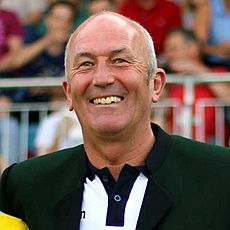
For the first three years, a committee managed the team. In 1897, William Ironside Groombridge, the club's secretary, took full charge. He became Gillingham's first official manager. Former England player Stephen Smith became full-time manager in 1906. He left in 1908, and Groombridge took over again. Groombridge worked with the club for over 25 years as manager and secretary.
When the club joined the Football League in 1920, Robert Brown was appointed manager. But he resigned a month later, before the season even started. His replacement, Scotsman John McMillan, became the first manager to lead the team in a Football League match.
In 1939, a year after the club left the Football League, Archie Clark became manager. He was still in charge when the club returned to the Football League in 1950. Clark stayed until 1957. Freddie Cox took over in 1962. He led the club to win the Football League Fourth Division championship in the 1963–64 season. This made him the first manager to win a Football League title with the club.
Basil Hayward was fired in 1971 after the club was relegated back to the Fourth Division. But his replacement, Andy Nelson, led the club to promotion back to Division Three three years later. He then surprisingly resigned.
Tony Pulis took over in 1995 when Gillingham was in the lowest division. He managed the club to promotion in his first season. Three years later, he led the team to the 1999 Second Division play-off final. However, he was fired right after for serious misconduct. Peter Taylor replaced him. Taylor led the club to a second straight play-off final in 2000. Gillingham won and was promoted to the second tier of English football for the first time. In 2013, Martin Allen became the second manager to lead the Gills to a Football League title. His team won the championship of League Two.
Club Achievements
Here are some of the main titles and awards Gillingham Football Club has won:
League Titles
- Second Division (level 3)
- Play-off winners: 2000
- Fourth Division / Third Division / League Two (level 4)
- Champions: 1963–64, 2012–13
- Runners-up: 1973–74, 1995–96
- Play-off winners: 2009
- Southern League
- Champions: 1946–47, 1948–49
- Southern League Division Two
- Champions: 1894–95
- Kent League
- Champions: 1945–46
Cup Wins
- Southern League Cup
- Winners: 1946–47
- Kent League Cup
- Winners: 1945–46
- Kent Senior Cup
- Winners: 1945–46, 1947–48
Statistics and Records
Goalkeeper Ron Hillyard has played the most games for Gillingham. He played 657 matches in all competitions between 1974 and 1990. Another goalkeeper, John Simpson, holds the record for most Football League appearances with 571 games from 1957 to 1972.
Brian Yeo is the club's top league goalscorer of all time, with 136 goals between 1963 and 1975. He also shares the record for most Football League goals in a single season, scoring 31 goals in the 1973–74 season. This matched the record set by Ernie Morgan in 1954–55. The most goals scored by a player in one professional game is six. This was achieved by Fred Cheesmur against Merthyr Town in April 1930.
The highest amount of money the club has received for a player is £1.5 million for Robert Taylor. He was sold to Manchester City in 1999. The most Gillingham has paid for a player is £600,000 for Carl Asaba, who joined from Reading in 1998.
The club's record home attendance is 23,002. This was for an FA Cup match against Queens Park Rangers on January 10, 1948. This record will likely never be broken unless the club moves to a much larger stadium, as Priestfield Stadium's current capacity is about half that.
The team's biggest professional win was a 10–0 victory over Chesterfield in September 1987. However, they had an even bigger win of 12–1 against Gloucester City in the Southern Football League in November 1946. The Gills hold the record for the fewest goals conceded by a team in a 46-game Football League season. This happened in the 1995–96 season, when goalkeeper Jim Stannard kept 29 clean sheets (games without letting in a goal).
Club Rivalries
A 2003 survey of football fans showed that no other team's supporters considered Gillingham to be one of their main rivals. Millwall is considered the closest team to a local rival for the Gills. Many fans see Swindon Town as the club's biggest rivals. This comes from heated matches between the teams in the past. While Swindon fans generally don't see Gillingham as a top rival, there was violence when they met at Priestfield in the 2005–06 season. This was their first meeting since a play-off match in 1987.
After their promotion in 1989, Maidstone United became Kent's second League team. A rivalry with Gillingham grew over the next few seasons. This ended when Maidstone had financial problems and left the League in 1992. A small rivalry between Gillingham and Fulham started after a Fulham fan was killed during a fight between both sets of fans outside Priestfield Stadium in March 1998.
In the 2024–25 EFL League Two season, Bromley joined the Football League. This created the possibility of a new rivalry for Gillingham, sometimes called the A2 Derby or "Kent" Derby. This is because the town of Bromley was historically part of Kent until Greater London was created in 1965.
More to Explore
- Brian Moore's Head Looks Uncannily Like London Planetarium – This was a fan magazine (fanzine) about the club. It existed from 1988 to 2006 as a printed magazine and later briefly online. It was named after the football commentator Brian Moore, who was a Gillingham supporter.
- Chatham Town WFC – This is a women's football club that used to be connected to Gillingham F.C.
See also
 In Spanish: Gillingham Football Club para niños
In Spanish: Gillingham Football Club para niños


